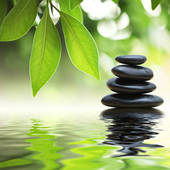How do I start Meditating?
Posted by: Rose Tol, R&I Life Coaching, February 22, 2013 in Meditation
 |
When we first begin to meditate, all kinds of resistance begin to arise. We sit down to meditate, and we may experience unwanted feelings like physical pain, sleepiness, and irritation. We find ourselves thinking all of the time and wonder if we are practicing correctly. We start to wonder if the practice is worth the effort and if it has any real benefits. Filled with resistance of all kinds, people often give up on meditation or find themselves in a perpetual “stop and start” mode. |
A skillful meditation teacher is able to act as a “coach” in these situations and offer the guidance that can be necessary to help someone continue to explore meditation at deeper and deeper levels. In a sense, learning to meditate is not any different than learning how to do anything that looks simple but is actually quite nuanced (like playing a sport or learning to play a musical instrument). Sure, you can learn some things from books and CDs, but imagine how much more you can learn when working with a teacher or coach who has decades of personal experience obtained from their own practice and from working with hundreds of other students. Additionally, we all need feedback from the outside when learning something new, we are on a learning curve after all, and an experienced teacher can offer invaluable feedback and support.
There are other significant benefits that can come from studying with a meditation teacher. The meditation teacher is able to “model” how to meditate. Being in the presence of a gifted teacher, you develop a feeling for the practice that is difficult to develop on your own. Imagine, for example, that you want to learn to play the piano. You can listen to recordings of wonderful piano concertos, but imagine how much more you would learn sitting on the bench next to a master pianist? You would feel their energy and passion, and could watch up close the movements of his or her hands across the keyboard. In this scenario, the inner experience of the pianist is being communicated in addition to their outer hand movements across the keys. There is a sort of “ignition,” a handing over of the experience from one person to another. This is why the exchange between a meditation teacher and a student is sometimes described as “the gift of fire” or passing wisdom “candle to candle.”
So my recommendation is: Find yourself a meditation teacher that fits you.
The Time line Approach.
Most of us usually go through an initial restless period in the first part of our meditations when our bodies are fidgeting and our minds are the busiest. If this happens and you start to become discouraged you can try using a time plan approach.
As best you can, when you’re meditating
- try to determine if you have an average time for going
through a restlessness period.
- Then, take that time and double it.
That is a good basic way to approach finding an adequate time period for you to practice your meditations.
For example; if for one week you notice that when you sit down you can’t settle down for approximately 5 to 15 minutes. Then your average meditation time could be somewhere between 10 to 30 minutes.
The idea is to make sure that you give yourself the best chance to feel some advancement in learning how to go within. It helps your overall level of self confidence in being able to go within if you feel at least a portion of the time you’re not just sitting there, wanting to stop, and trying not to want to stop.
"If you have not succeeded ever, yet, on an inward journey, be gentle
with yourself.
Give yourself time. Gently let yourself go deeper.
Whatever experience comes to you, let it take you over.
Welcome it. Relish it.”
Gourasana
Prepare Your Self
The more you prepare yourself for your meditation, you will notice it will start to pay off in your meditation work.
Imagine yourself being a painter and your job is to paint a house. In preparation you think through what tools and supplies you need for the job, your clean the house, your prep the walls etc.etc. A painter can tell you, the more prepared he is the faster and better he gets the job done. The same is true for meditation. The more prepared and focused you are at the start of your meditation the more you will gain benefit from your meditation.
Preparing yourself for meditation can be many different things like; preparing a quiet and beautiful space, preparing your mind, focusing on your intent for the meditation during the day. If you like to know about how to best prepare yourself for meditation then go here.
A Good Way to Start!
A
good way to begin your journey within is by starting to explore the
reasons why you want to meditate. Being in touch with your reason(s) to
meditate, and then taking this as a focus into your meditation work is a very
important key. I call your reasons and intent our spiritual desire.
This spiritual
desire is to meditation what the sun is to human life: we need the sun
to keep our life forces going, and we need spiritual desire to sustain
our focus and endeavors in each second of meditation. Everything stems
from your spiritual desire. You do not have to see it as “spiritual
desire” if that does not resonate with you. You can see it as your
motivation, your intention, or your drive to improve and evolve.
Whatever you call it, this kind of desire is a feeling within, and is
what sustains your focus as you meditate.
You can explore this in the selfawareness exercise #1